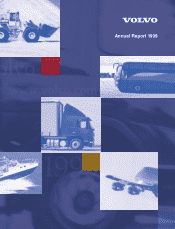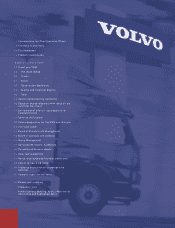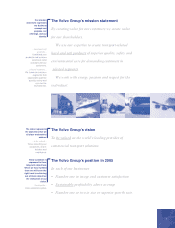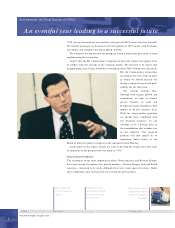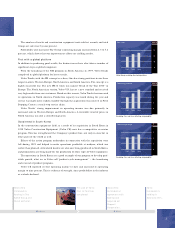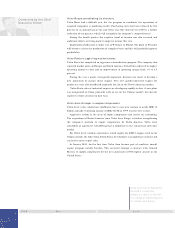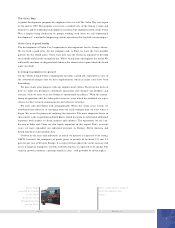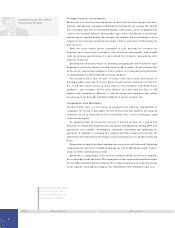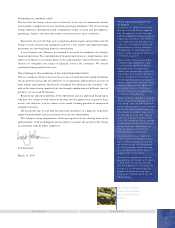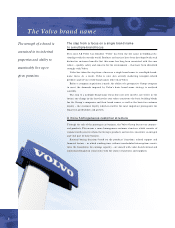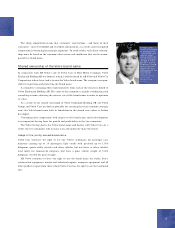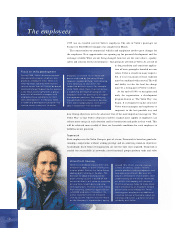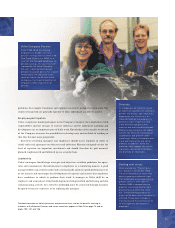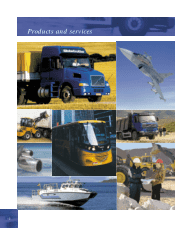Volvo 1999 Annual Report Download - page 9
Download and view the complete annual report
Please find page 9 of the 1999 Volvo annual report below. You can navigate through the pages in the report by either clicking on the pages listed below, or by using the keyword search tool below to find specific information within the annual report.
7
Form ation of common units
The fact that the Group is now active exclusively in the area of commercial vehicles
and machines is important for our continuing earnings performance. We are increasing
Group efficiency through increased coordination within research and development,
purchasing, logistics, the after-sale market, financial services and e-commerce.
Powertrain, the new driveline unit, is producing diesel engines and gearboxes for the
Group’s trucks, construction equipment and buses. Our marine and industrial engine
operations are also benefiting from the coordination.
A new business unit, Finance, was formed at year-end to coordinate the Group’s
financial operations. The consolidation of financial operations in a single business unit
allows us to operate as a stronger player in the capital market, which will create oppor-
tunities to strengthen our range of financial services for customers. We foresee
continued strong growth in this area.
The offering to the custom er is the m ost im portant factor
The new and more efficient structure that we have created provides a good foundation
for our growth strategy. The key objective is to expand the industrial base in terms of
both volume and expertise and thereby strengthen our offering to the customer – not
only in the form of more products but also through combinations of different types of
products, services and IT solutions.
Based on our industrial platform, Volvo, Mitsubishi and any additional brand names
will have the resources with which to develop and strengthen their respective busi-
nesses. O ur objective is to be valued as the world’s leading provider of commercial
transport solutions.
All this means that we can look forward with confidence to a high rate of growth,
improved profitability and an increased return for our shareholders.
The Group is strong and possesses all the prerequisites to be a driving force in the
global market. I will work happily and forcefully to continue the growth of the Group
in association with all fellow employees.
Leif Johansson
March 20, 2000
NOVEM BER DECEM B ER
Agreement on closer
cooperation between
Volvo and Mitsubishi
Motors.
Volvo’s planned acquisition
of Scania
On March 14, 2000, the EU Com -
mission rejected Volvo’s applica-
tion for approval of the fair-com-
petition aspects of Volvo’s proposed
acquisition of Scania. The Comm is-
sion’s decision was based on the
view that a m erger of Volvo and
Scania would result in reduced
com petition in the m arkets for
heavy trucks and buses mainly in
the Nordic countries.
Volvo’s offer to the shareholders
in Scania was conditional upon
the necessary approvals being
obtained from the regulatory
authorities concerned, as was the
acquisition of Investor’s shares in
Scania. Based on the decision of
the EU Com m ission to not approve
Volvo’s acquisition of Scania, Volvo
cannot im plement the agreem ent
to acquire Investor’s holding of
Scania shares, or the public offer
to Scania’s shareholders.
Volvo’s present holding in Scania,
which am ounts to 30.6 percent of
the voting rights and 45.5 percent
of the share capital, is not affected
by the EU Com m ission’s decision.
The shares have been acquired at
an average price of SEK 266 per
share, or a total of slightly more
than SEK 24 billion. Volvo intends
to retain this holding for the tim e
being. However, Volvo does not
plan to request a position on
Scania’s Board of Directors.
The EU Com mission’s decision
means that the projected integra-
tion of Volvo and Scania will not
be im plemented. The com panies
will now consider whether there
are conditions for other form s of
cooperation in the future.
Another consequence of not im-
plem enting the merger with Scania
is that other structural changes
can be expected in the future. As
a result, it is not meaningful at
present to form ulate any new
long-term financial goals for the
Volvo Group.

